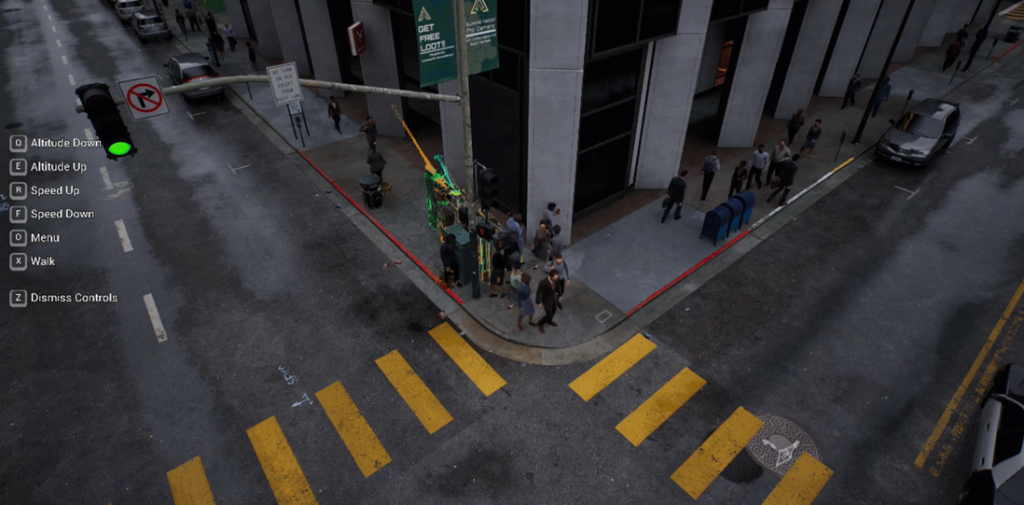Unreal Engine is a widely-used game engine developed by Epic Games. It provides a suite of tools for creating interactive 3D and 2D experiences, including video games, architectural visualizations, virtual reality (VR) simulations and more. Unreal Engine 5, the latest incarnation of the software, launched in April 2022, representing a trailblazing moment in the Gaming industry as creators benefitted from a tremendous step forward in terms of creative freedom, visual fidelity and development flexibility. In the game development industry, Unreal Engine has a market share of 16.56%, an ever-growing figure.
The quality of the interactive 3D experiences on Unreal Engine is such that it has managed to find a home in the CRE industry. With its advanced capabilities and unparalleled versatility, Unreal Engine is revolutionising how commercial real estate professionals showcase properties, train personnel, collaborate on designs and market their services. Let’s delve deeper into how Unreal Engine is reshaping the landscape of commercial real estate.
Enhanced marketing materials
Unreal Engine empowers professionals to create compelling marketing materials that captivate and inspire. Whether promotional videos, interactive presentations, or immersive experiences, real estate professionals can utilise Unreal Engine to differentiate their properties in a crowded market and attract potential clients. Gone are the days of static images and floor plans, potential clients can now explore every corner of a property in stunning detail. From the lobby to the boardroom, users can navigate through spaces as if they were physically there, gaining a comprehensive understanding of layout, design and ambience. This level of immersion not only enhances the client experience but also enables remote viewing. This has been taken on by the luxury residential market, with examples being Serenia Living (Dubai), Kō’ula at ward village (Honolulu) and Kensington Residences (London).

Interactive visualisations
Beyond traditional presentations, Unreal Engine empowers professionals to offer interactive visualisations that engage project stakeholders on a whole new level. Global project teams can review plans, provide feedback and make decisions in real-time. Stakeholders can view a space and flick through the potential design options with their price tags, allowing project teams to steamroll through the design process at unprecedented pace. The ability to immerse in such detail with all stakeholders allows future sticking points to be anticipated and addressed far earlier on in the project process, fuelling operational efficiency gains.

Training simulations
In addition to its prowess in property visualisation, Unreal Engine offers powerful tools for training simulations. Property management staff, maintenance personnel, and security teams can engage in training sessions on Unreal Engine to enhance their understanding of various property procedure. Whether it be practicing the Fire Drill or preparing for a one-off event with high security demands, Unreal Engine gives people a safe and controlled environment to train. Going further, Commercial Real Estate professionals can utilise the MassEntity function on Unreal Engine 5 to run the mass simulation of property-related protocol. This could help property managers understand the effect of different numbers of people on evacuation times and as a result, impose capacity requirements on the space to comply with local regulation.

Urban master planning integration
In the fast-paced and intricate world of commercial real estate, urban master planning stands as a critical yet challenging element. It’s not just about envisioning a development, it’s about effectively communicating that vision to decision-makers, investors and stakeholders. This early phase sets the tone for the entire project, dictating its trajectory over years, even decades. Developers are now embracing immersive 3D planning environments powered by Unreal Engine, transforming the pre-concept phase into a more efficient and engaging process.
A prime example of this accelerated planning is V2i Realtime’s collaboration with Lendlease on the Figtree Hill project in south-west Sydney, Australia. By creating spatially accurate 3D models using Unreal Engine, V2i Realtime communicated the scale and vision of the project to stakeholders, including government bodies and local authorities. While nuanced, the capability to view a development at various times of the day or observe the proposed evolution across multiple years offers unprecedented access to the envisioned project, fostering more profound discussions and smoothing the path for planning and development approval processes.


Similarly, London-based firm Cityscape Digital leveraged Unreal Engine for the Canada Water redevelopment in South East London, enabling stakeholders to visualise the construction process from conception to completion.

From immersive virtual tours to showcasing the future of our communities, Unreal Engine offers a comprehensive suite of tools that empower professionals to improve process for stakeholders and achieve operational efficiency gains during the project. The CRE industry has historically been a late adopter of technology but the pace of Web 3.0 transformation is challenging this former reluctance. The clear benefits of using Unreal Engine against traditional methods means the software is a fascinating case study to test the industry’s current receptiveness to creative disruption.





